[Editor’s Note: This step-by-step guide follows the BSF production system of the ECHO Asia Small Farm Resource Center in Chiang Mai, Thailand. This is only one example of a functional system and should be adapted according to local context and availability of inputs. This article aims to elaborate on a ‘scaled-up’ system, adding to the wide variety of materials written about backyard and household BSF production.]
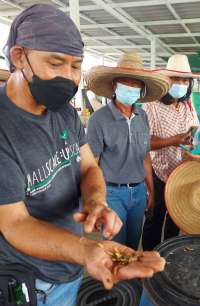
Figure 1. Author displays healthy Black Soldier Fly larvae to workshop participants at the ECHO Asia Small Farm Resource Center.
Introduction to Black Soldier Fly Production
Critical to the success of a small-scale farm is its ability to turn on-farm waste into alternative value-added products. By integrating the Black Soldier Fly (Hermetia illucens) on the farm, small-scale enterprises can do just that. Taking common waste products such as food scraps and manure, the Black Soldier Fly can be used to efficiently convert raw waste materials into high-protein feed sources for livestock, while simultaneously producing a by-product suited for amending soils.
The production of BSF larvae also has particular potential for areas in which feed protein sources are difficult to come by. In remote mountainous regions for example, the production of pigs, poultry, and fish are often limited by the availability of affordable protein inputs such as fishmeal and/or soy meal. Black Soldier Fly larvae production may be suited as an affordable alternative. While, humans can safely consume BSF larvae as well, the focus of this article will target production of feed sources for livestock.
There are many potential advantages to producing BSF and few drawbacks. Of particular note, BSF are extremely efficient converters of waste, can be produced quickly, and require a comparatively small footprint to other livestock or agricultural enterprises. It is also important to note that the Black Soldier Fly is not considered a pest, a common misconception. The BSF is not a known vector of disease, nor does it bite or sting.
Production of BSF Larvae |
|---|
| Advantages |
| Waste can be converted efficiently into a useful, high-protein feed source |
| BSF larvae are packed full of energy |
| Low overall production costs |
| Larvae can deactivate pathogens in waste materials |
| Not considered as a pest to humans, nor as a vector of disease |
| By-products (or casts) can be used as valuable soil amendments |
| BSF have a short life cycle and be produced quickly |
| Disadvantages |
| Potential for foul smells |
| Pest pressure (birds and rats) |
| Cultural acceptance |
Nutritional Value of BSF Larvae

Figure 2. Nutritional break down of [dehydrated] Black Soldier Fly (Hermetia illucens) larvae. Source: Feedipedia, 2021.
The larvae of the BSF are packed full of nutrients, both in quantity and quality. In addition to their high percentage levels of protein and fat content, larvae offer a complete nutritional make-up, including micronutrients, chitins, amino acids, and vitamins. Figure 2 below offers a snapshot of the nutritional make-up of the BSF larvae. For further details and break down of individual nutritional components of BSF larvae, see summary article by Barragan-Fonseca et al., 2017.
A Step-By Step Guide to Scaled-Up BSF Production
This photo guide tracks the current Black Soldier Fly production system of the ECHO Asia Small Farm Resource Center, located outside of Chiang Mai, Thailand. This particular system aims to produce a steady flow of BSF larvae for feed of chickens and fish on the farm, but should not be considered large-scale or industrial by any means. Many resources currently exist online for the set-up and maintenance of small backyard BSF systems, such as those produced in buckets, bins, and barrels, but this system aims to produce larger quantities of larvae at various stages of production and life cycle. At the time of writing, this system consistently produces larvae in the range of 10 kilograms per week.
Step 1. Getting Started
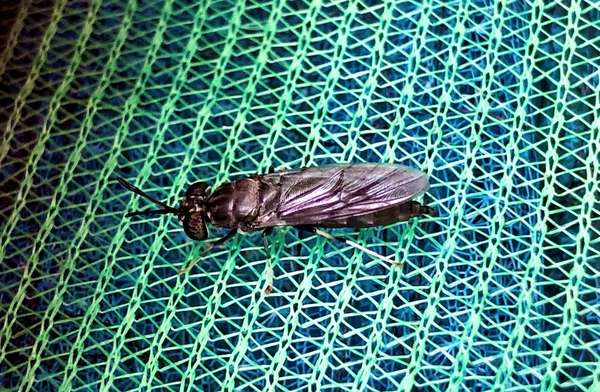
Figure 3. Close up of an adult Black Soldier Fly (Hermetia illucens).
As noted earlier in the article, the Hermetia illucens (Figure 3) can be found in most parts of the world, having adapted itself from its native region of the Americas into a now commonly seen insect species. To start a BSF production system, flies can either be captured from the wild or purchased from a local source. This article assumes the latter, that the reader is starting with eggs, larvae, or adult flies already in hand.
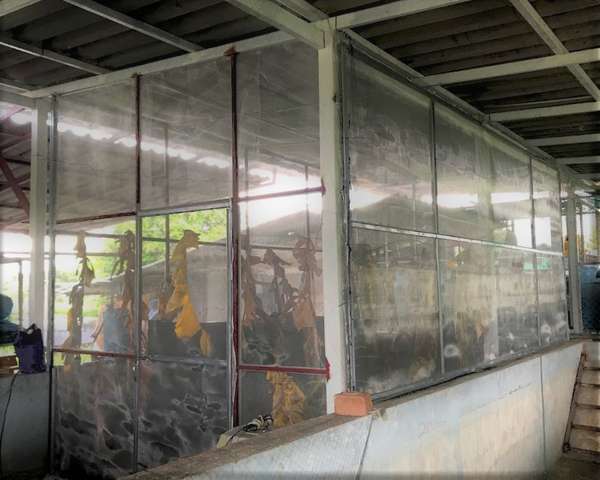
Figure 4. The screened-in BSF mating enclosure, including a dark room and overhead sprinklers for moisture control. Here adult flies mate and females will lay their eggs.
Step 2. Establishing a Mating Enclosure
The establishment of a mating enclosure is critical to the production of eggs, the primary step in producing BSF larvae. Such enclosures depend on the targeted scale of the enterprise, with many options and adaptations available. Mating enclosures can range from large screened-in rooms such as the above example from the ECHO Asia Farm, or smaller systems that utilize mosquito nets or even mesh laundry baskets. No matter the scale or design, it is necessary that the mating enclosure maintain adequate moisture and temperature. It is also critical that these enclosures remain sealed environments, both to keep the BSF in, and pests such as bird and rats out.
Within this enclosure a few provisions should be made for the adult flies, including a water source, some vegetation and surface on which to hide and mate, and a ‘dark room’ inside of which females will lay their eggs. At his stage in their life cycle, neither the pupae nor the mature adults will eat any food, therefore only a small food source is provided for the purposes of enticing the females to lay their eggs.
Step 3. Collecting Eggs
In order to collect the eggs of the adult female BSF, provisions must be made within the mating enclosure. At the ECHO Asia Farm we have discovered that small blocks of wood work well, providing both an inviting egg-laying environment for the female flies and a convenient mode of egg collection for staff. It is common practice to use small pieces of cardboard as egg laying material (Wong, 2020), however we prefer the aforementioned method as it is more convenient for the collection of eggs and tends to result in higher quantities of eggs. At this stage it is important to note that BSF do not lay their eggs directly on (or in) a food source, but rather nearby to one. Therefore, laying blocks should be situated nearby a food source, as depicted in Figure 5.
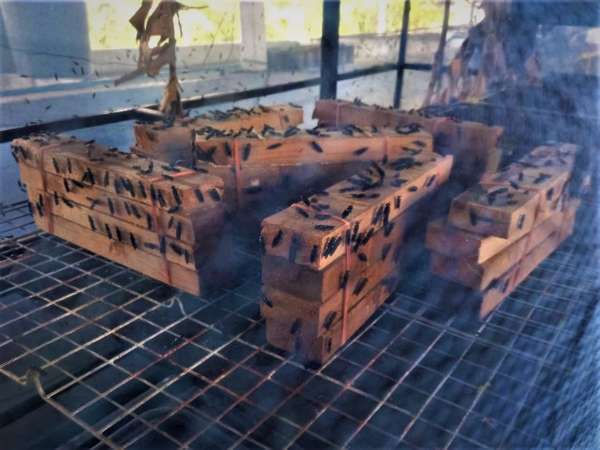
Figure 5. Inside the breeding enclosure, wooden blocks with small crevices are provided for the female BSF to lay their eggs. Blocks are placed above a food source, but not directly in contact with the food source.
In order to collect eggs, blocks should be removed, separated, and carefully scraped off. It is important to note at this stage that eggs can be of different ages if the blocks are not removed each day. By having eggs of different ages, the larvae will hatch and grow at different stages, requiring additional sorting and separating at maturity. Ideally, when producing larger batches of BSF, it is better to have larvae at uniform age and maturity. Typically, a mature female will produce anywhere from three to four hundred eggs in her lifetime.
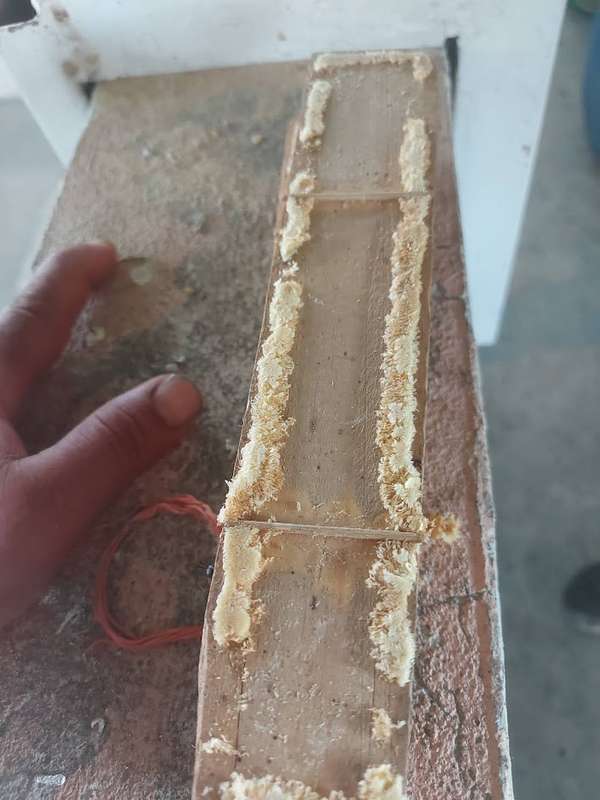
Figure 6. Once the eggs have been laid, the wooden blocks can be removed and taken apart for easier access to the eggs. Toothpicks are used to separate blocks to provide small gaps in which females may deposit their eggs.
Step 4. Transitioning from Eggs to Larvae
Once eggs have been collected, they can be transferred to a food source where they will hatch and crawl their way to the nearby feedstock provided. Eggs will typically hatch within 4 days of being laid. At this stage, when larvae remain small, plastic trays can be used to hold small quantities of feed/waste and larvae. Mesh screen is used to keep the eggs from directly contacting the food source.
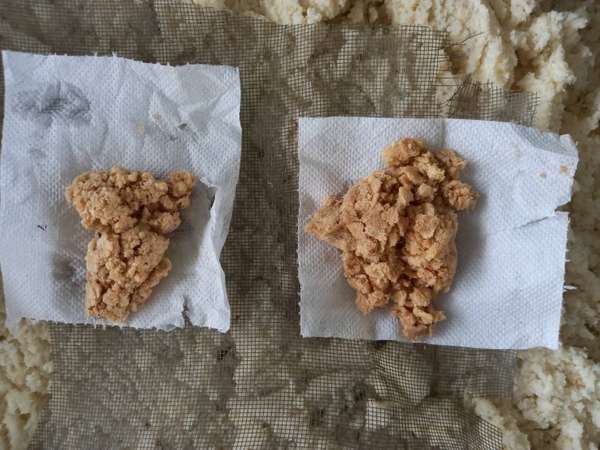
Figure 7. Collected eggs can be gently placed on top of the food source. Eggs are laid on screen mesh to avoid direct contact with the moist food. Once eggs hatch, they will quickly find their way to the food source.
Step 5. Selecting Appropriate Feedstock
One of the great benefits of the Black Soldier Fly is its ability to consume a wide array of different products, consuming market waste (fruit & vegetable), manure, table scraps, bone meal, and most other products. This article will not provide a prescriptive list of feed sources, but rather encourages the producer to identify the so-called ‘waste’ resources available to him/her. Ideally, low-cost, or even free, waste by-products should be targeted, including market waste, cafeteria food scraps, rice bran, brewer’s spent grains, soy cake, etc…
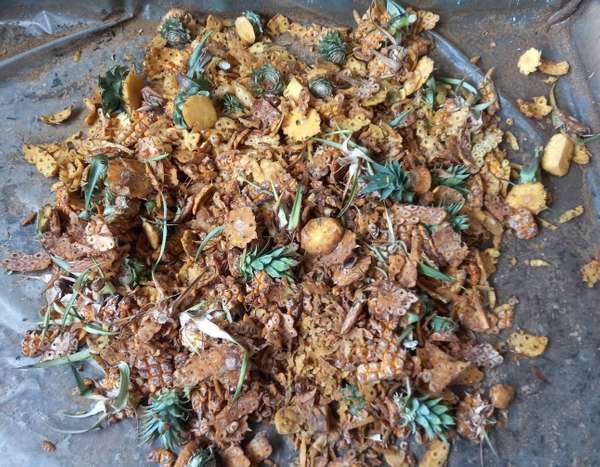
Figure 8. Many food source options exist for the production of BSF larvae, such as pineapple waste byproducts collected from the market, as seen here.
In order to ensure a balanced, or ‘complete’ feed source, it is recommended to mix a number of various waste resources together. This helps ‘bulk up’ the feedstock to ensure higher yields of larvae produced, but is not necessary.
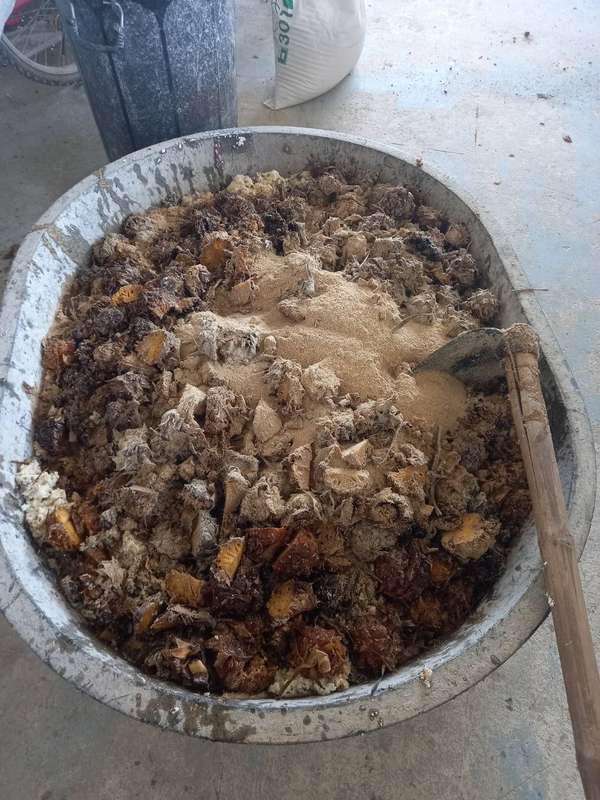
Figure 9. To ensure that BSF larvae grow strong and healthy, it is possible to mix higher quality waste byproducts such as rice bran and soy meal, with lower quality waste byproducts.
Step 6. Stepping Up Production
As larvae hatch and feed, they will need to be ‘stepped up’ into larger containers or bays for adequate production. During this step, additional feedstock is provided and larvae are left to eat.
***NOTE: It is critical to control moisture to avoid foul smells and rotting feed material. Piles of feed or waste should never be allowed to go anaerobic. Trays or bays should have a way to drain off moisture to avoid any standing liquid. On the ECHO Asia Farm, we use a dry material such as rice bran or rice powder to rapidly absorb moisture when needed.
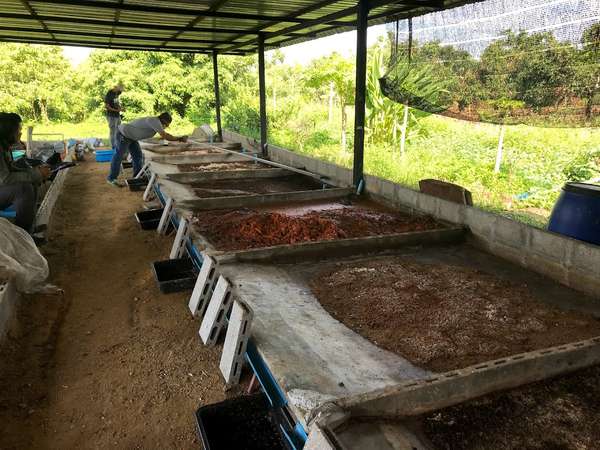
Figure 10. A scaled-up Black Soldier Fly system at a local farm in northern Thailand. This farm uses individual bays with different waste sources to grow BSF larvae at various stages of their life cycles.
Step 7. Knowing When to Harvest Larvae
Within the next 13 to 18 days larvae will feed voraciously, eating as much as twice their own body weight each day. It is critical during this time to identify the desired stage at which to harvest the larvae. At the end of the larval stage, before reaching the pre-pupae stage (Figure 11), larvae will reach their maximum nutrional capacity as a feed resource (Barragan-Fonseca et al., 2017). If harvested too late the producer runs the risk of lower feed quality, whicle harvesing too early might mean missing out on additional weight and size, and therefore potentially higher yields.
It is important to note that the decision to harvest larvae at this stage, before reaching maturity, will likely require some form of sorting or sizing, or separation of larvae from their feed material. This can be a laborious task and it is recommended that screens of various sizes be used in this process. Mechanized shakers do exist and can be repurposed for this purpose, or it can be done manually.

Figure 11. The life cycle of the Black Soldier Fly (Hermetia illucens), lasting approximately 45 days in its entirety. Before reaching the pre-pupal stage, BSF larvae are at their maximum nutritional quality as a feed resource. Source: Nutrinews 2020.
Step 8. Sorting and Sizing
In order to produce larvae at their peak nutritional stage they must be ‘harvested’ from their feed material. This involves some level of sorting and screening to isolate the larvae. This can be done with various sizes of screens and is made easier by transferring larvae to a finer feed source at the end of their production, allowing for easier separation. This can be done by hand or through investment in mechanized shakers, similar to technologies used in vermicast systems. For larvae that are fed directly, it may not be necessary to clean them completely.

Figure 12. Sorting and sizing BSF larvae.
Step 9. The Final Product
These larvae are at their final and most nutritionally rich stage, before turning into pupae, at which time their nutritional value will begin to decline.
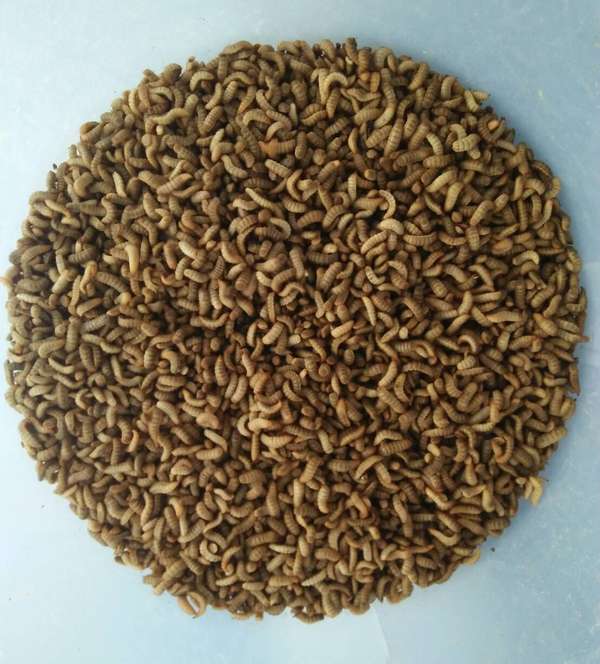
Figure 13. The final product!
Step 10. Raising Pupae for Reproduction Purposes
Many BSF systems take advantage of the ‘self-harvesting’ nature of the BSF pupae. At this stage in its life, a BSF pupae will migrate from its food source in search of a dark quiet place to transform into a mature fly. As seen in the example above (Figure 14), many set-ups have been designed to funnel the crawling pupae out of the food source and into a bucket or other catchment arrangement. This is an extremely convenient phenomenon, but as noted earlier, only happens at the pupal stage when the BSF has already passed its prime as a feed source.
At the ECHO Asia Farm we have found that the ‘self-harvesting’ system works very well for [re]supplying the mating enclosure. If checked regularly it can be convenient and is capable of providing a steady supply of pupae for reproduction purposes.
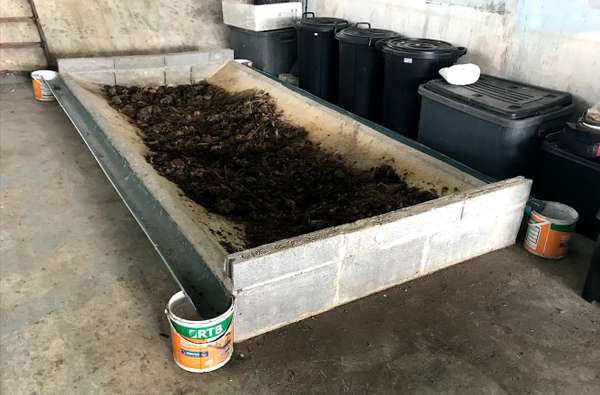
Figure 14. A BSF larvae ‘self-harvesting’ bay. When pupae have reached the end of their pupal cycle, they will crawl away from their food source and will fall into the troughs where they can be collected.
Production Challenges to Consider
Pests
Pests such as birds, rats, and other critters should be considered before establishing a BSF system of any scale. Closed systems are necessary to keep flies in and unwanted pests out. Unfortunately, this necessary process of installing screens and nets can become expensive, and adds significantly to a producer’s bottom line.
Foul Smells
As previously mentioned, it is critical to the success of any BSF system to control moisture properly. Many food wastes, such as fruit scraps, contain high moisture contents and can lead to systems that become anaerobic. Preventing this from happening is not only crucial to the success of the overall system, but also to overall smell and subsequent perception of neighbors and clients. As previously mentioned, it is recommended to install drainage options and to keep on hand substances such as rice bran and rice flour that can be added to rapidly absorb moisture.
Uses of Black Soldier Fly Products
Livestock Feeds
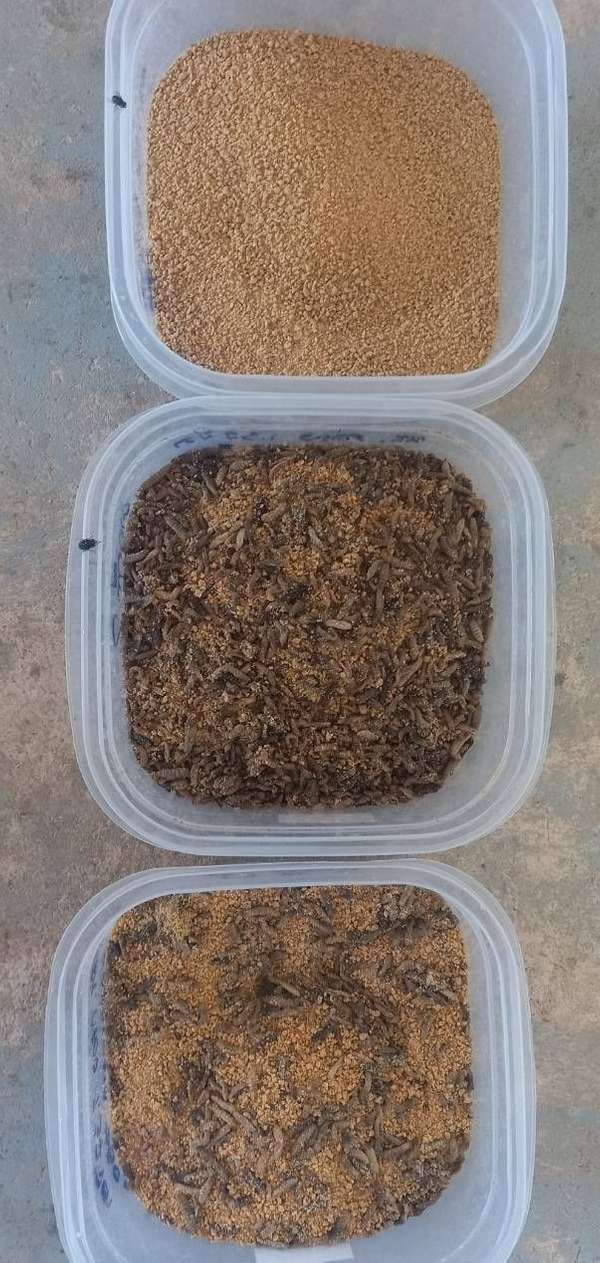
Figure 15. Comparison of commercial chicken feed supplemented with various rates of BSF larvae at the ECHO Asia Farm. In this case, larvae are being integrated whole.
While it is possible to produce BSF larvae for human consumption, the primary impetus for producers remains as a source for livestock feed, particularly fish and poultry. Larvae can be fed directly, or they can be integrated into an existing feed ration. Staff on the ECHO Asia Farm are currently experimenting with commercial fish and chicken feeds supplemented with various rates of BSF larvae (Figure 15). To use larvae practically and regularly, they can be fed fresh, whole, dried, ground, or frozen depending on the context and equipment available to the producer.
Soil Amendment
In addition to the larvae produced, BSF also leaves behind a valuable manure similar to vermicasts. These ‘casts’ or ‘frass’ can be applied to soil as a rich amendment, providing additional value to an overall production system. In commercial enterprises this by-product is often bagged and sold as a separate product, another income generating component the small and medium producer might consider. At a minimum, this product can be reintegrated onto the farm in vegetable beds, nursery potting mixes, etc…
Lastly, there also comes with the production of BSF a liquid product that can be collected and used to amend soils. This liquid can be collected during the feeding process when larvae are voraciously consuming waste products such as food scraps, manure, and other feedstock materials.
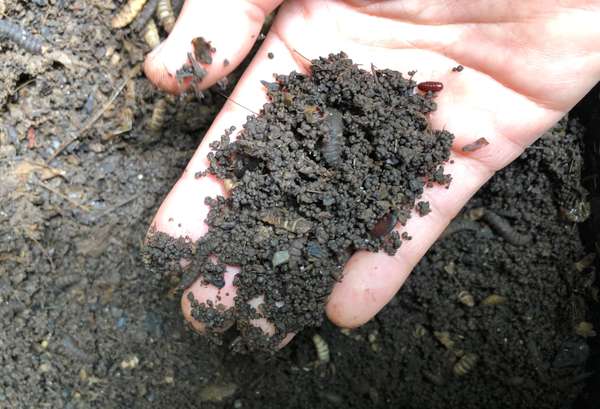
Figure 16. BSF ‘casts’ or ‘frass’. A potentially valuable by-product of BSF production systems.
Conclusion
BSF production may or may not be beneficial on every farm or every context. Critical to any success will be the identification of an affordable, preferably free waste resource to serve as feedstock for the production of BSF. In many cases, BSF have been identified as an economical solution to the management of existing farm waste, such as manure and other un-used by-products.
Acknowledgments
The authors would like to thank Mr. Phai from Phai BSF Ecofarm CNX, for his willingness to share is his knowledge and experience. We learned so much from you, thank you.
References
Barragan-Fonseca, K.B., M. Dicke, and J.J.A. van Loon. 2017. Nutritional value of the black soldier fly (Hermetia illucens L.) and its suitability as animal feed – a review. Journal of Insects as Food and Feed. 3(2): 105-120. Available: https://avingstan.com/wordpress/wp-content/uploads/2019/08/Barragan-Fonseca-et-al-2017-Nutritional-value.pdf
Feedipedia, 2021. Tables of chemical composition and nutritional value of Black soldier fly larvae (Hermetia illucens), dehydrated. Available: https://www.feedipedia.org/node/16388
Nutrinews. 2020. Using black soldier fly larvae as a source of protein. The Animal Nutrition. Available: https://theanimalnutrition.com/using-black-soldier-fly-larvae-as-a-source-of-protein/
Wong, A. 2020. Black Soldier Fly of the Frangipani Langkawi Organic Farm. ECHO Asia Notes. 41. Available: https://www.echocommunity.org/en/resources/e3d5b1f1-0ec8-4a86-97e0-d80f26e7a951